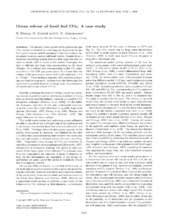| dc.contributor.author | Drange, Helge | eng |
| dc.contributor.author | Alendal, Guttorm | eng |
| dc.contributor.author | Johannessen, Ola M. | eng |
| dc.date.accessioned | 2005-04-26T13:04:29Z | |
| dc.date.available | 2005-04-26T13:04:29Z | |
| dc.date.issued | 2001-07-01 | eng |
| dc.Published | Geophysical Research Letters 28(13): 2637-2640 | |
| dc.identifier.issn | 0094-8276 | |
| dc.identifier.uri | https://hdl.handle.net/1956/657 | |
| dc.description.abstract | The natural ocean uptake of the greenhouse gas CO2 can be accelerated by collecting and liquefying the gas from point sources, and by pumping it into the ocean at appropriate locations and at sufficient depths. Results from a numerical modelling system indicate that injection sites located at about 1,000 m depth in the eastern Norwegian Sea lead to efficient and long term sequestration in the abyss Atlantic. For a release rate corresponding to the CO2 emissions from a 220 MW gas power plant, it is found that the volume of the near-source water with a pH-reduction ≥ 0.1 is ~0.5 km³. These findings, together with available technology and feasible economics, indicate that the Norwegian Sea represents a possible location for large scale demonstration of operational ocean release of CO2. | en_US |
| dc.format.extent | 337551 bytes | eng |
| dc.format.mimetype | application/pdf | eng |
| dc.language.iso | eng | eng |
| dc.publisher | American Geophysical Union | eng |
| dc.subject | Global Change: General or miscellaneous | eng |
| dc.subject | Oceanography: Biological and chemical | eng |
| dc.subject | Carbon cycling | eng |
| dc.subject | Modeling | eng |
| dc.title | Ocean release of fossil fuel CO2: A case study | eng |
| dc.type | Journal article | eng |
| dc.type | Peer reviewed | eng |
| dc.description.version | publishedVersion | |
| dc.rights.holder | Copyright 2001 by the American Geophysical Union | |
| dc.identifier.doi | https://doi.org/10.1029/2000gl012609 | |
| dc.source.journal | Geophysical Research Letters | |
| dc.source.40 | 28 | |
| dc.source.14 | 13 | |
| dc.source.pagenumber | 2637-2640 | |
